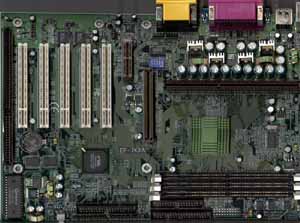The argument against Athlon motherboard support is a faltering one simply because there are some very solid Athlon motherboards on the market. Using the AMD 750 chipset, ASUS’ K7M and K7M-RM are excellent solutions with the latter being a nice board for a low-cost Athlon system since it is basically the K7M available in the microATX form factor.
Other than ASUS, we have Microstar and Gigabyte shipping some very solid motherboards that, if used with proper memory modules and a powerful enough power supply, are great for building a reliable and stable Athlon system.
VIA’s recent introduction of the KX133 chipset, the first non-AMD Athlon chipset, as well as the announcement that 20 or so motherboard manufacturers would be producing motherboards based on the chipset have increased the number of options a user has when building an Athlon system.
Mainly because of its borrowed design from VIA’s P6 level chipsets, primarily the Apollo Pro 133A, there are very few compatibility or stability issues present with the KX133. This is a huge relief because we expected the exact opposite judging by VIA’s track record, but with the AGP core, the memory controller and the South Bridge all borrowed from previous VIA chipsets, the only problems VIA could have had would be with the implementation of the EV6 bus onto their reference design which proved to be an accomplishable task.
Motherboard manufacturers are having a much easier time with the KX133 than the AMD 750 because of the noticeably lower cost of the KX133 as well as the 4-layer reference board design provided by VIA versus the 6-layer design most AMD 750 motherboards follow. While Microstar recently produced a motherboard (MS-6195) based on AMD’s 4-layer Athlon motherboard design, most manufacturers will opt for VIA’s KX133 design because it is simply a cheaper design.
EPoX 7KXA - KX133
EPoX and ASUS have KX133 designs that will soon be available that are very solid designs. We’ve been testing both of their KX133 boards for a little while now and we can say that they are very reliable options and they will definitely be two of the most desired motherboards once they become more available in the market.
It seems like the tables have definitely been turned here in terms of motherboard support. While AMD used to be lagging behind with only a handful of motherboards the 133MHz FSB motherboard market isn’t doing too well right now. Currently, the only decent performing and affordable 133MHz platform is the Apollo Pro 133A, and 133A boards are still in their stages of perfection.
Revision CE of the VIA 694X is just now making its way into the market and it will be a couple more weeks until the new revisions get out into all 133A boards. What Revision CE accomplishes is it fixes some AGP 4X problems that were originally in the CD revision of the North Bridge. The performance of the 133A motherboards is noticeably less than the BX platform, this is primarily because of the memory timing issues with the memory controller of the 133A’s North Bridge.
The i820 chipset would be the perfect 133MHz FSB solution for the Pentium III if it weren’t for the fact that the chipset only has native support for RDRAM, a memory technology that is currently entirely too expensive for most users. With RDRAM currently retailing at around three to five times the cost of SDRAM, it isn’t a viable option for most users. Also, the yields on RDRAM have been reportedly quite bad, resulting in an even higher cost on the higher speed modules (i.e. PC800).
Using SDRAM, the i820 chipset takes a huge performance hit, thus eliminating that option for 133MHz FSB motherboards, so for the 133MHz FSB Pentium IIIs the only real option is the Apollo Pro 133A chipset.
Intel is supposed to release their i815 chipset, with PC133 SDRAM support soon, but our sources have told us that the chipset may be released as late as June of this year, eliminating it as an option for those users that are buying systems within the next month.
From a motherboard support standpoint, the Athlon is looking much better than it did back at its introduction 6 months ago.











0 Comments
View All Comments